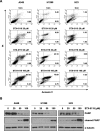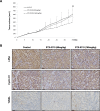Inhibition of STAT3 signaling induces apoptosis and suppresses growth of lung cancer: good and bad
- PMID: 32257917
- PMCID: PMC7081529
- DOI: 10.1186/s42826-019-0030-0
Inhibition of STAT3 signaling induces apoptosis and suppresses growth of lung cancer: good and bad
Abstract
Signal transducer and activator of transcription 3 (STAT3) modulates a variety of genes involved in the regulation of critical functions, including cell proliferation, differentiation, apoptosis, angiogenesis, metastasis, and immunity. For many cancers, elevated levels of STAT3 signaling have been associated with a poor prognosis and the development of chemotherapy resistance. In this study, we investigated the inhibitory effects of a novel small-molecule inhibitor of STAT3, STX-0119, on the cell viability and survival of human lung cancer cells. STX-0119 inhibited activated STAT3 and the expression of STAT3-regulated oncoproteins such as c-Myc, cyclin D1, and survivin in lung cancer cells. STX-0119 also decreased the amount of STAT3 in the nuclear fraction as well as induced apoptosis of these lung cancer cell lines as evidenced by increases in apoptotic cells (Annexin V positive) and poly (ADP-ribose) polymerase (PARP) cleavage. The efficacy of STX-0119 in a mouse xenograft model was confirmed. However, a hematological side effect, which had not been previously reported, was observed. The level of white blood cells was significantly lowered when treated at the dose at which STX-0119 alone showed a significant tumor-suppressive effect. In conclusion, we suggest that STX-0119 may be a potent therapeutic agent against lung cancer. Consideration of the side effect suggests, it is necessary to study whether low-dose STX-0119 is effective for lung treatment with a combination of classic lung cancer therapeutics.
Keywords: Cancer; NSCLC; STAT3 inhibitor; STX-0119; Xenograft.
© The Author(s) 2019.
Conflict of interest statement
Competing interestsThe authors declare that they have no competing interests.
Figures




Similar articles
-
Effect of the STAT3 inhibitor STX-0119 on the proliferation of cancer stem-like cells derived from recurrent glioblastoma.Int J Oncol. 2013 Jul;43(1):219-27. doi: 10.3892/ijo.2013.1916. Epub 2013 Apr 23. Int J Oncol. 2013. PMID: 23612755
-
Antitumor activity of a novel small molecule STAT3 inhibitor against a human lymphoma cell line with high STAT3 activation.Int J Oncol. 2011 May;38(5):1245-52. doi: 10.3892/ijo.2011.957. Epub 2011 Feb 28. Int J Oncol. 2011. PMID: 21369699
-
KCP10043F Represses the Proliferation of Human Non-Small Cell Lung Cancer Cells by Caspase-Mediated Apoptosis via STAT3 Inactivation.J Clin Med. 2020 Mar 5;9(3):704. doi: 10.3390/jcm9030704. J Clin Med. 2020. PMID: 32150979 Free PMC article.
-
Mild oxidative stress induces S-glutathionylation of STAT3 and enhances chemosensitivity of tumoural cells to chemotherapeutic drugs.Free Radic Biol Med. 2013 Dec;65:1322-1330. doi: 10.1016/j.freeradbiomed.2013.09.015. Epub 2013 Oct 1. Free Radic Biol Med. 2013. PMID: 24095958
-
Multicellular Effects of STAT3 in Non-small Cell Lung Cancer: Mechanistic Insights and Therapeutic Opportunities.Cancers (Basel). 2021 Dec 11;13(24):6228. doi: 10.3390/cancers13246228. Cancers (Basel). 2021. PMID: 34944848 Free PMC article. Review.
Cited by
-
Metabolite-derived protein modifications modulating oncogenic signaling.Front Oncol. 2022 Sep 23;12:988626. doi: 10.3389/fonc.2022.988626. eCollection 2022. Front Oncol. 2022. PMID: 36226054 Free PMC article. Review.
-
Radiation Potentiates Monocyte Infiltration into Tumors by Ninjurin1 Expression in Endothelial Cells.Cells. 2020 Apr 28;9(5):1086. doi: 10.3390/cells9051086. Cells. 2020. PMID: 32353975 Free PMC article.
-
Targeting STAT3 Enzyme for Cancer Treatment.Mini Rev Med Chem. 2024;24(13):1252-1261. doi: 10.2174/0113895575254012231024062619. Mini Rev Med Chem. 2024. PMID: 38299278 Review.
-
Induction of Apoptosis by Coptisine in Hep3B Hepatocellular Carcinoma Cells through Activation of the ROS-Mediated JNK Signaling Pathway.Int J Mol Sci. 2020 Jul 31;21(15):5502. doi: 10.3390/ijms21155502. Int J Mol Sci. 2020. PMID: 32752099 Free PMC article.
-
Overexpression of IL-6 and STAT3 may provide new insights into ovine pulmonary adenocarcinoma development.BMC Vet Res. 2025 Jan 20;21(1):29. doi: 10.1186/s12917-024-04429-6. BMC Vet Res. 2025. PMID: 39833798 Free PMC article.
References
-
- Gkouveris I, Nikitakis N, Sauk J. STAT3 signaling in Cancer. J Cancer Ther. 2015;06(08):709–726. doi: 10.4236/jct.2015.68078. - DOI
LinkOut - more resources
Full Text Sources
Molecular Biology Databases
Research Materials
Miscellaneous

